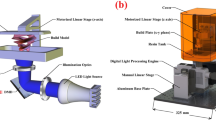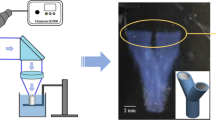Abstract
Microstereolithography (MSTL) is a SFF technology that has been used to fabricate 3-D scaffolds in tissue engineering. Projection-based microstereolithography (pMSTL) offers the advantage of increased fabrication speed compared with a line-scan-based MSTL by creating 2-D patterns with single-section image exposure and then stacking them. To fabricate a complex 3-D structure for a target tissue (liver, blood vessel, etc.) using the pMSTL system, we introduce a new algorithm that automatically generates projection image information. The procedure uses the STL file format as the raw data for a 3-D model. First, the STL file data are converted into slicing data composed of closed loops, including layer thicknesses. Projection image data are then generated from the closed loops calculated during the slicing process. Finally, the projection image data are converted into pixel information. The proposed technique is evaluated by fabricating a complex 3-D vascular network structure, and is shown to be quite practical for automated fabrication of complex 3-D structures in tissue engineering.
Similar content being viewed by others
References
Cho, Y. H., Lee, I. H. and Cho, D. W., “Laser scanning path generation considering photopolymer solidification in microstereolithography,” Microsystem Technologies, Vol. 11, No. 2–3, pp. 158–167, 2005.
Kang, H. W., Seol, Y. J. and Cho, D. W., “Development of an indirect solid freeform fabrication process based on microstereolithography for 3-D porous scaffolds,” J. Micromech. Microeng., Vol. 19, No. 1, Paper No. 015011, 2009.
Lee, J. W., Lee, S. H., Kim, J. Y., Lee, B. K. and Cho, D. W., “In-vivo Bone Formation of a Scaffold that Releases BMP-2 Fabricated Using Solid Freeform Fabrication,” Proc. of 2nd World Congress of the Tissue Engineering and Regenerative Medicine International Society, p. S29, 2009.
Liao, Y. S. and Chiu, Y. Y., “A new slicing procedure for rapid prototyping system,” Int. J. Adv. Manuf. Tech., Vol. 18, No. 8, pp. 578–585, 2001.
Lee, J. W., Lan, P. X., Kim, B., Lim, G. and Cho, D. W., “3D scaffold fabrication with PPF/DEF using microstereolithography,” Microelectronic Engineering, Vol. 84, No. 5–8, pp. 1702–1705, 2007.
Sachols, E., Resia, N., Ainsely, C., Derby, B. and Czemuszka, J. T., “Novel collagen scaffold with predefined internal morphology made by solid freeform fabrication,” Biomaterials, Vol. 24, No. 8, pp. 1487–1497, 2003.
Sakai, Y., Otsuka, M., Hanada, S., Nishiyama, Y., Konishi, Y. and Yamashita, A., “A novel poly-L-lactic acid scaffold that possesses a macroporous structure and a branching/joining three-dimensional flow channel network: its fabrication and application to perfusion culture of human hepatoma Hep G2 cells,” Materials Science and Engineering C: Biomimetic and Supramolecular Systems, Vol. 24, No. 3, pp. 379–386, 2004.
Kitaoka, H., Takaki, R. and Suki, B., “A three-dimensional model of the human airway tree,” J. Appl. Physiol., Vol. 87, No. 6, pp. 2207–2217, 1999.
Murray, C. D., “The physiological principle of minimum work: I. The vascular system and the cost of blood volume,” Proc. of the Natl. Acad. Sci. USA, Vol. 12, No. 3, pp. 207–214, 1926.
Lu, Y., Mapilli, G., Suhali, G., Chen, S. and Roy, K., “A digital micro-mirror device-based system for the microfabrication of complex, spatially patterned tissue engineering scaffolds,” J. Biomed. Mater. Res. A, Vol. 77, No. 2, pp. 396–405, 2006.
Jamieson, R. and Hacker, H., “Direct slicing of CAD models for rapid prototyping,” Rapid Prototyping J., Vol. 1, No. 2, pp. 4–12, 1995.
Luo, R. C., Yu, P. T., Lin, Y. F. and Leong, H. T., “Efficient 3D CAD model slicing for rapid prototyping manufacturing systems,” Proc. of the 25th Annual Conference of the IEEE Industrial Electronics Society, Vol. 3, pp. 1504–1509, 1999.
Kim, H. C., Choi, K. H., Doh, Y. H. and Kim, D. S., “Optimal scan path generation for digital mirror system in SFFS,” International Conference on Control, Automation and Systems, pp. 2816–2820, 2007.
Kim, D. S., Lee, W. H., Bae, S. W. and Choi, K. H., “Development and performance evaluation of solid freeform fabrication system by using dual laser sintering process,” J. Laser Appl., Vol. 19, No. 4, pp. 232–239, 2007.
Park, I. B., Ha, Y. M., Kim, M. S. and Lee, S. H., “Fabrication of a micro-lens array with a nonlayered method in projection microstereolithography,” Int. J. Precis. Eng. Manuf., Vol. 11, No. 3, pp. 483–490, 2010.
Kim, H. J., Wie, K. H., Ahn, S. H., Choo, H. S. and Jun, C. S., “Slicing algorithm for polyhedral models based on vertex shifting,” Int. J. Precis. Eng. Manuf., Vol. 11, No. 5, pp. 803–807, 2010.
Author information
Authors and Affiliations
Corresponding author
Rights and permissions
About this article
Cite this article
Jung, J.W., Kang, HW., Kang, TY. et al. Projection image-generation algorithm for fabrication of a complex structure using projection-based microstereolithography. Int. J. Precis. Eng. Manuf. 13, 445–449 (2012). https://doi.org/10.1007/s12541-012-0057-8
Received:
Accepted:
Published:
Issue Date:
DOI: https://doi.org/10.1007/s12541-012-0057-8




